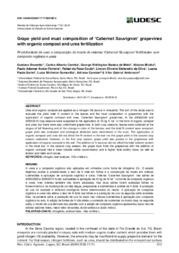Grape yield and must composition of "Cabernet Sauvignon" grapevines with organic compost and urea fertilization.
Grape yield and must composition of "Cabernet Sauvignon" grapevines with organic compost and urea fertilization.
Author(s): BRUNETTO, G.; CERETTA, C. A.; MELO, G. W. B. de; MIOTTO, A.; FERREIRA, P. A. A.; COUTO, R. da R.; SILVA, L. O. S. da; GALET, L. P.; SMAVILLA, L. M.; CANCIAN, A.; AMBROSINI, V. G.
Summary: Urea and organic compost are applied as a nitrogen (N) source in vineyards. The aim of this study was to evaluate the yield, total N content in the leaves and the must composition in grapevines with the application of organic compost and urea. ?Cabernet Sauvignon? grapevines, in the 2008/2009 and 2009/2010 crop seasons were subjected to the application of 40 kg N ha-1 in the form of organic compost and urea; but there were also unfertilized grapevines. In both crop seasons, leaves were collected at the stages of full flowering and at the change in color of the berries, and the total N content were analyzed; grape yield was evaluated and enological attributes were determined in the must. The application of organic compost and urea did not affect the N content in the leaf nor the grape yield in the second crop season evaluated. However, in the first crop season, grape yield was greater in the grapevines with application of organic compost to the soil. The addition of N sources did not affect the total nutrient content in the must but, in the second crop season, the grape must from the grapevines with the addition of organic compost had a lower soluble solids concentration and a higher total acidity value, as well as tartaric and malic acid values. KEYWORDS: nitrogen, leaf analysis, Vitis vinifera L.
Publication year: 2019
Types of publication: Journal article
Unit: Embrapa Grape & Wine
Keywords: Leaf analysis, Nitrogen, Vitis vinifera L
Observation
Some of Embrapa's publications are published as ePub files. To read them, use or download one of the following free software options to your computer or mobile device. Android: Google Play Books; IOS: iBooks; Windows and Linux: Calibre.
Access other publications
Access the Agricultural Research Database (BDPA) to consult Embrapa's full library collection and records.
Visit Embrapa Bookstore to purchase books and other publications sold by Embrapa.

